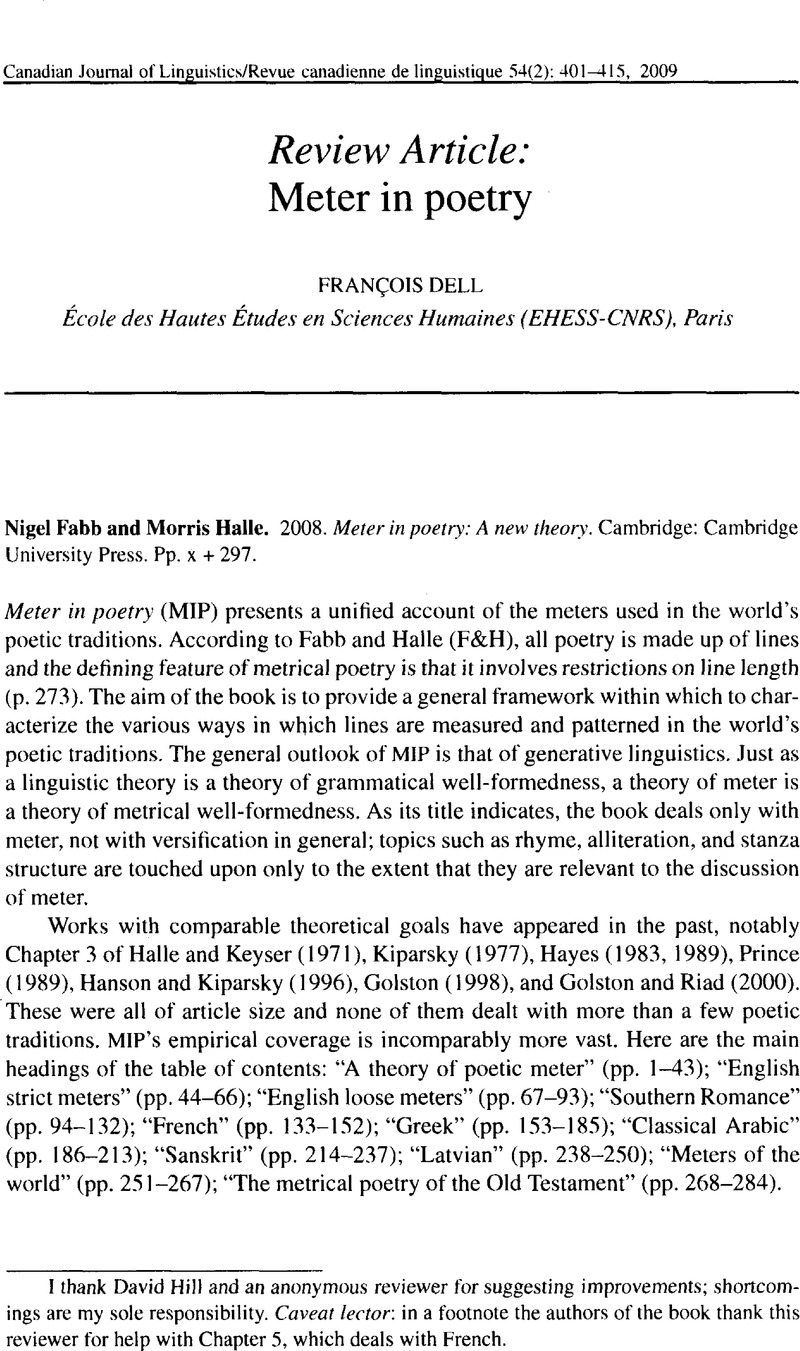No CrossRef data available.
Article contents
Meter in poetry
Review products
FabbNigel and HalleMorris. 2008. Meter in poetry: A new theory. Cambridge: Cambridge University Press. Pp. x + 297.
Published online by Cambridge University Press: 27 June 2016
Abstract
An abstract is not available for this content so a preview has been provided. Please use the Get access link above for information on how to access this content.

- Type
- Review Article/Article Compte-Rendu
- Information
- Canadian Journal of Linguistics/Revue canadienne de linguistique , Volume 54 , Issue 2 , July 2009 , pp. 401 - 415
- Copyright
- Copyright © Canadian Linguistic Association/Association canadienne de linguistique 2009
References
Chomsky, Noam, and Halle, Morris. 1968. The sound pattern of English. New York: Harper and Row.Google Scholar
Cornulier, Benoît de. 1995. Art poëtique : Notions et problèmes de métrique. Lyon: Presses Universitaires de Lyon.Google Scholar
Dell, François, and Elmedlaoui, Mohamed. 2008. Poetic meter and musical form in Tashlhiyt Berber songs. Cologne: Rüdiger Köppe.Google Scholar
Fabb, Nigel. 2002. Language and literary structure. Cambridge: Cambridge University Press.Google Scholar
Golston, Chris. 1998. Constraint-based metrics. Natural Language and Linguistic Theory 16:719–770.Google Scholar
Golston, Chris, and Riad, Tomas. 2000. The phonology of Classical Greek meter. Linguistics 38:99–167.Google Scholar
Halle, Morris, and Idsardi, William. 1995. General properties of stress and metrical structure. In A handbook of phonological theory, ed. Goldsmith, John A., 403–443. Oxford: Black-well.Google Scholar
Halle, Morris, and Keyser, Samuel J.. 1971. English stress: Its form, its growth, and its role in verse. New York: Harper and Row.Google Scholar
Halle, Morris, and Keyser, Samuel J.. 1999. On meter in general and on Robert Frost’s loose iambics in particular. In Linguistics: In search of the human mind. A festschrift for Kazuko Inoue, ed. Muraki, M. and Iwamoto, E., 130–153. Tokyo: Kaitakusha.Google Scholar
Halle, Morris, and Vergnaud, Jean-Roger. 1987. An essay on stress. Cambridge, MA: MIT Press.Google Scholar
Hanson, Kristin, and Kiparsky, Paul. 1996. A parametric theory of poetic meter. Language 72:287–335.Google Scholar
Hayes, Bruce. 1983. A grid-based theory of English meter. Linguistic Inquiry 14:357–393.Google Scholar
Hayes, Bruce. 1989. The prosodic hierarchy in meter. In Phonetics and phonology, vol. 1: Rhythm and meter, ed. Kiparsky, Paul and Youmans, Gilbert, 201–260. San Diego: Academic Press.Google Scholar
Kiparsky, Paul. 1977. The rhythmic structure of English verse. Linguistic Inquiry 8:189–247.Google Scholar
Prince, Alan. 1989. Metrical forms. In Phonetics and phonology, vol. 1: Rhythm and meter, ed. Kiparsky, Paul and Youmans, Gilbert, 45–80. San Diego: Academic Press.Google Scholar


